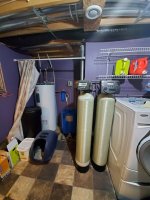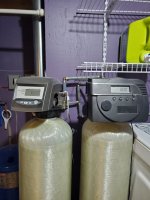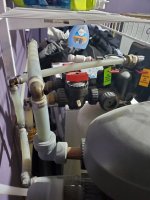mobile goat
New Member
Hello all,
I just moved into a new house that has a water softening system. I've never had one before and am just trying to figure out what I have and what I need to do to maintain it.
There are two tanks connected in series that each have an independent regen cycle every 3 days. What I mean is that each tank has its own control valve and the two don't talk to each other. The brine tank is only hooked up to the first tank (on the left).
So my questions are pretty general - what do I have here, what does it do, and what do I need to do to keep it running? Should I periodically hook the brine tank up to the second tank? Do I just feed it salt and that's it? All help is much appreciated.



I just moved into a new house that has a water softening system. I've never had one before and am just trying to figure out what I have and what I need to do to maintain it.
There are two tanks connected in series that each have an independent regen cycle every 3 days. What I mean is that each tank has its own control valve and the two don't talk to each other. The brine tank is only hooked up to the first tank (on the left).
So my questions are pretty general - what do I have here, what does it do, and what do I need to do to keep it running? Should I periodically hook the brine tank up to the second tank? Do I just feed it salt and that's it? All help is much appreciated.



